Back to Flooring Products
Engineered Wood Flooring Compared to Other Types of Wood Flooring
The flooring world is definitely spoiling you of choice. Even besides the great variety of different types of flooring, including carpet, stone, or ceramic and porcelain tiles, even if you are focused on wood flooring only and this is what you are looking for, you still have a lot of choices and different options to consider. Wood flooring and wood mimicking flooring are available in a really impressive variety of options and types, different materials, structures, profiles, finishes and what not.
There is practically a type of real wood or wood mimicking flooring that can suit everyone’s interior, budget, desires, needs, requirements. It is important to choose the right type of flooring depending on the specifics of the project and what you need, the requirements of the specific area where the floor will be installed. It is also important to understand the difference between different types of flooring and flooring made out of different wood species.
While the wood species mainly concern the colour, texture, grade, and overall appearance of the flooring, the types of flooring refer to the way the floorboards are put together, the materials used for manufacturing them, whether they will be natural or synthetic, real wood or vinyl. There is no doubt that all types of real wood and wood mimicking flooring have an unbeatable beauty and they are suitable and complement all sorts of interiors. However, appearance is not all you have to consider when choosing a floor for your home or office.
Recently, engineered wood flooring gained the popularity of being super-advanced, almost superior to other types of wood and wood mimicking flooring available on the market. While it is the truth that engineered wood flooring has a very advanced structure and design, it is not necessarily the best choice for every project. Therefore, in order to help you understand whether it will be better for your project to choose engineered wood flooring or other types of wood flooring and make the best decision, today we will have an overview of all five categories of real wood and wood mimicking flooring types and discuss more the advantages and disadvantages of all of them.
Vinyl Flooring
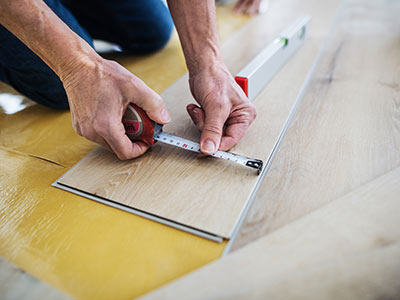 Vinyl flooring is not a new product on the market. However, the way it feels and looks nowadays is something new. Back in the days, vinyl floors used to have this bad rep of looking tacky and ugly. Not anymore. Nowadays, vinyl floors are manufactured to look amazing and they are really a high-quality flooring option. Vinyl floors are available in three different types – sheets, floorboards, and tiles, and they come in a great variety of designs.
Vinyl flooring is not a new product on the market. However, the way it feels and looks nowadays is something new. Back in the days, vinyl floors used to have this bad rep of looking tacky and ugly. Not anymore. Nowadays, vinyl floors are manufactured to look amazing and they are really a high-quality flooring option. Vinyl floors are available in three different types – sheets, floorboards, and tiles, and they come in a great variety of designs.
Probably the most popular type of vinyl flooring is the one mimicking hardwood flooring. Keep in mind that vinyl floors are not made out of natural wood and are a synthetic material. This, however, makes vinyl floors high resilient and durable and very resistant to moisture, scratches, wear and tear. Therefore, vinyl floors are a great choice for every home and commercial space, especially high-traffic areas and rooms, where moisture, humidity and temperature fluctuations could otherwise be a problem for a real wood floor, such as the kitchen, bathroom, basement.
Advantages:
- Vinyl floors are extremely durable and hard-wearing. You don’t have to worry about scratches and dents or signs of wear and tear with a vinyl floor.
- Vinyl flooring is also a very affordable and budget-friendly option, especially compared to real wood flooring.
- Installation of vinyl flooring is quick and easy and some vinyl floors are even suitable as a DIY project for inexperienced but enthusiastic handymen.
- Vinyl flooring is available in a really impressive variety of designs and styles.
- This type of flooring is really easy to maintain in good condition and cleaning it does not require a lot of time, energy, money or elbow grease.
Disadvantages:
- Vinyl floors do not stand up to very heavy loads and heavy footfall, therefore they are not suitable for industrial settings. This type of flooring can also struggle with marks from sharp objects, including high heels and some heavy furniture pieces.
- The colour of your vinyl floor may start fading over time, especially if exposed too much to direct sunlight.
Laminate Flooring
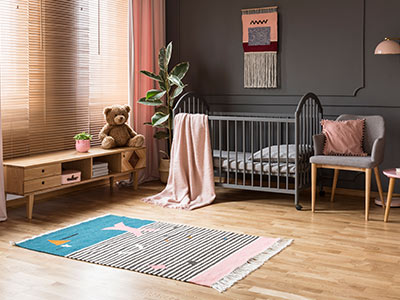 Laminate flooring is probably the first thing that comes to your mind when thinking of a type of flooring that is not made out of real wood materials but looks exactly like wood. It is a classic and budget-friendly choice.
Laminate flooring is probably the first thing that comes to your mind when thinking of a type of flooring that is not made out of real wood materials but looks exactly like wood. It is a classic and budget-friendly choice.
Besides its affordability, laminate flooring is often selected for all the cases when you want to enjoy the timeless beauty and elegance of real wood in rooms and areas, where moisture and humidity could be a problem. Unlike solid wood flooring, laminate flooring is significantly less prone to moisture and water damage.
Laminate flooring may look like real wood, but there is no real wood used for its manufacturing. The effect is achieved by placing a photographic image of a wooden texture under a clear protective layer. Laminate flooring is a great choice for all areas of the house and also for commercial settings.
Advantages:
- Laminate flooring provides you with the elegant aesthetic of real wood, however, without the hassle of the more complex and challenging hardwood flooring upkeep and without the need to splurge on an expensive floor.
- Laminate flooring is easy to install and it is a great option for DIY projects.
- The surface of laminate flooring is less prone to scuffs and scratches compared to real wood flooring, which means it is also a very durable and long-lasting product.
- Laminate flooring is also available in a wide variety of designs, colours, and even textures.
Disadvantages:
- Unfortunately, even the most expensive and high-quality laminate flooring does not look or feel exactly like real wood flooring.
- Great installation is important, poor installation will make the floor look shabby.
- Once the laminate floor wears off or if the surface is damaged, it is almost impossible to fix it and the only solution is replacing it.
- Laminate flooring does not last as long as a hardwood floor, which means that every thirty years, at most, and you will have to replace it.
- Laminate flooring cannot be re-sanded or refinished because it is not made out of real wood.
Parquet Flooring
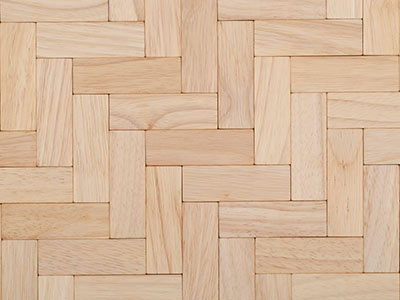 Parquet flooring is probably the most classic wood flooring option. It has been around for many years and it is still a well-loved favourite of many homeowners. Parquet flooring is usually made out of hardwood, however, it can also be made out of engineered wood floorboards and even laminate.
Parquet flooring is probably the most classic wood flooring option. It has been around for many years and it is still a well-loved favourite of many homeowners. Parquet flooring is usually made out of hardwood, however, it can also be made out of engineered wood floorboards and even laminate.
The classic parquet floor is no different from any other solid wood floor. However, the difference comes from the way parquet floors are laid – to create different patterns. Parquet floor patterns are composed of smaller wooden or laminate blocks that are fitted in a way to create geometrical and angular style shapes.
Parquet flooring is highly appreciated for its decorative effect besides its durability and functionality. Parquet flooring is prone to water and moisture damage, therefore it should be installed only in dry areas where the environment should be relatively constant.
Advantages:
- Parquet flooring is probably the most beautiful of all flooring options and it is the most decorative, for sure. Besides the variety of colours, textures, shades, and undertones, parquet flooring is also available in a wide variety of patterns.
- Parquet flooring is relatively easy to maintain. It does require a specific upkeep and cleaning routine, however, this routine does not have to be time-consuming, expensive or too challenging.
- Parquet floors can be re-sanded and refinished up to a few times in their lifecycle, which means their appearance and condition can be improved and different issues and imperfections can be fixed.
- Parquet flooring is durable, hard-wearing and long-lasting. Simply make sure it is not exposed to temperature fluctuations, moisture and humidity.
- Parquet flooring adds value to your home.
Disadvantages:
- Parquet flooring is prone to scratches, scuffs, and marks. A hard-wearing finish is necessary for protecting the floorboards.
- The colour of your parquet floor may start fading over time when excessively exposed to direct sunlight.
- Like all types of real wood flooring, parquet flooring is also prone to damages caused by moisture and humidity.
- Parquet flooring requires frequent upkeep. You need to consider re-sanding and refinishing every few years, while polishing may be required even more often.
Solid Wood Flooring
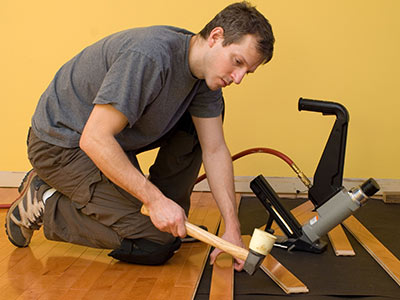 Solid wood flooring is pretty much the epitome of real wood flooring. Every solid wood floorboard is cut from a single piece of timber with no different layers in addition to the hardwood core. Solid wood floors are usually fitted using a tongue-and-groove profile, which involves either the usage of nails or adhesive.
Solid wood flooring is pretty much the epitome of real wood flooring. Every solid wood floorboard is cut from a single piece of timber with no different layers in addition to the hardwood core. Solid wood floors are usually fitted using a tongue-and-groove profile, which involves either the usage of nails or adhesive.
All wood species used for solid wood floor manufacturing have a different hardness score according to the Janka hardness rating system. Solid wood floors are a great choice for the living room, bedroom, and hallway, and overall all areas and rooms that are with constant and low humidity and moisture content.
Advantages:
- Solid wood flooring comes in a great variety of colours, textures and grades because it is made out of a great variety of wood species.
- Solid wood flooring possesses timeless beauty and elegance and adds a lot of value to every property.
- Solid wood flooring can be re-sanded and refinished, which means it can look brand-new even after years of heavy use.
- Solid wood flooring is considered to be the most long-lasting wood floor option available. If maintained properly and regularly, it is designed to last up to a whole century.
Disadvantages:
- Solid wood flooring is prone to water and moisture damage. Fixing issues and damages caused by moisture is not that easy and can be expensive.
- Solid wood flooring is not easy to install, if you want the installation to be flawless, therefore professional service is necessary.
- Generally, solid wood flooring has the highest price compared to all other flooring solutions on this list.
Engineered Wood Flooring
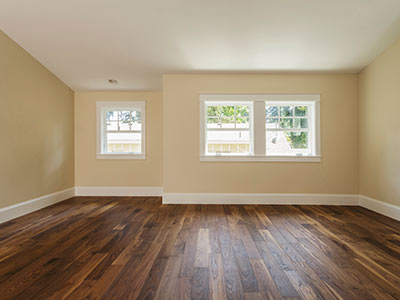 Finally, let’s find out a bit more about the advanced engineered wood flooring. It is often described as advanced because it has a very specific structure that is designed like so in order to make the floor less prone to water damage and shrinking, expanding and contracting caused by humidity and temperature fluctuations.
Finally, let’s find out a bit more about the advanced engineered wood flooring. It is often described as advanced because it has a very specific structure that is designed like so in order to make the floor less prone to water damage and shrinking, expanding and contracting caused by humidity and temperature fluctuations.
Therefore, unlike solid wood flooring, engineered wood flooring can be installed in areas such as the kitchen, basement and even the bathroom. Engineered wood flooring is more resilient and hard-wearing than solid wood flooring.
Every floorboard consists of layers of plywood, softwood, wood fibres or other wood materials that are glued together crisscrossed. The core is then topped with a hardwood layer with different thicknesses. This allows engineered wood floorboards to also be re-sanded and refinished.
Advantages:
- Engineered wood flooring is more resistant to moisture and humidity than classic solid wood flooring.
- Engineered wood floorboards are less likely to buckle or gap. Their structure of layers makes them more stable and solid.
- Engineered wood floorboards can be installed at any level of the building, including below-ground basements.
- It is more inexpensive than a solid wood floor.
- Engineered wood flooring is very durable and hard-wearing.
Disadvantages:
- Not that this is a disadvantage, engineered wood floorboards are available in a tongue-and-groove and click-lock installation profile and tongue-and-groove is harder to install than click-lock.
- Engineered wood flooring is more expensive than laminate and vinyl flooring.
The Bottom Line
It is hard to tell if engineered wood flooring is the best choice for every project. Indeed, all the rest types of flooring mentioned in this article are great and they can look great and last for a really long time when installed under the right circumstances and in the right environments. However, engineered wood flooring is, indeed, the most versatile option.
You can install an engineered wood floor pretty much everywhere in the house and it is also suitable for high-traffic commercial premises. Engineered wood flooring comes with a lot of benefits and advantages and it hardly has any disadvantages or drawbacks. In addition, engineered wood flooring looks as elegant and beautiful as a solid wood floor. Sometimes it is even impossible to tell the difference between these two when installed.